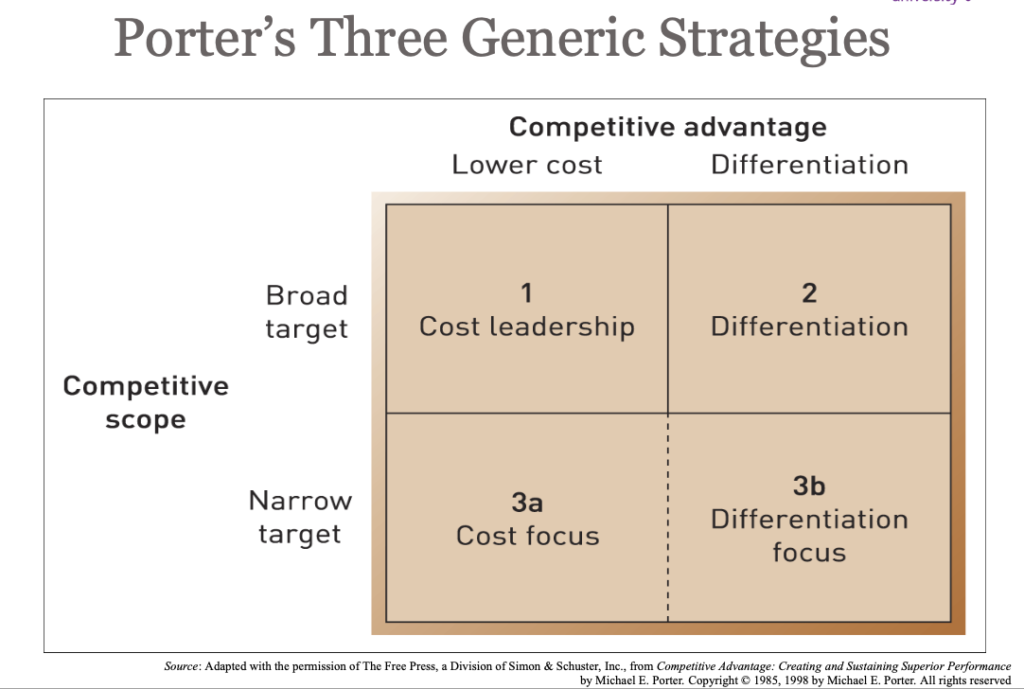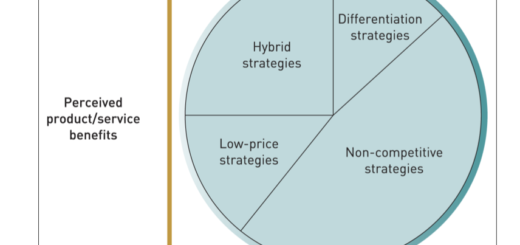Porter’s Generic Strategies
Porter’s generic strategy is a framework developed by Michael Porter that describes three basic strategies that a business can adopt to achieve and sustain competitive advantage. These strategies are based on a company’s relative position in the market and the competitive forces that it faces.

The three strategies are:
Cost Leadership:
This strategy involves focusing on minimizing costs to offer products or services at a lower price than competitors. A company can achieve cost leadership through economies of scale, efficient production processes, or by leveraging its bargaining power with suppliers. This strategy is most effective in markets where customers are price-sensitive and are willing to sacrifice other product features to get a better price.
Four key cost drivers that can help deliver cost leadership:
- Lower input costs.
- Economies of scale.
- Experience.
- Product process and design.
Differentiation:
This strategy involves offering products or services that are unique and differentiated from those of competitors. The differentiation can be based on product features, design, quality, brand image, customer service, or other factors that create value for customers. This strategy is most effective in markets where customers are willing to pay a premium for differentiated products.
Differentiation involves uniqueness along some dimension that is sufficiently valued by customers to allow a price premium. Two key issues:
- The strategic customer on whose needs the differentiation is based.
- Key competitors – who are the rivals and who may become a rival.
Focus:
This strategy involves targeting a narrow segment of the market and tailoring products or services to meet the specific needs of that segment. This can be done through a narrow product line, geographic focus, or by serving a particular customer group. This strategy is most effective in markets where there are specific customer needs that are not being met by other companies.
Two types of focus strategy:
- cost-focus strategy
- differentiation focus strategy
The purpose of Porter’s generic strategy is to help companies develop a competitive advantage by focusing on their strengths and taking advantage of the unique opportunities in their market. By choosing one of these strategies, companies can position themselves for success and differentiate themselves from competitors. However, it is important to note that the choice of strategy depends on the company’s resources, capabilities, and the characteristics of the market in which it operates.
Porters Arguement on the topic “Stuck in the middle”
According to Porter, a company that fails to adopt any of these strategies and tries to pursue all of them at the same time will be “stuck in the middle.” This means that the company will not be able to achieve a sustainable competitive advantage because it will not be able to compete effectively on either cost or differentiation.
Being “stuck in the middle” is not a desirable position for a company because it is likely to result in low profitability, limited market share, and lack of brand recognition. Therefore, companies should carefully assess their resources, capabilities, and the competitive environment before choosing a specific strategy and committing to it fully.
Example of “Stuck in the Middle”
One example of a company that was stuck in the middle and failed to implement a clear strategy is Sears, once a leading department store chain in the United States. In the 20th century, Sears was known for its low-cost products and was a pioneer in mail-order retail. However, in the 21st century, the company faced intense competition from online retailers such as Amazon and brick-and-mortar discount stores such as Walmart.
Sears attempted to compete by adopting a hybrid strategy, which combined elements of cost leadership, differentiation, and focus. It tried to offer low prices, while also differentiating its product offerings with its proprietary brands and exclusive merchandise. It also tried to appeal to specific market segments, such as home improvement enthusiasts, with its Craftsman and Kenmore brands.
However, Sears’ lack of focus and failure to fully commit to a single strategy resulted in high operating costs and low profitability. The company’s stores became cluttered with merchandise and its customer service declined. As a result, Sears lost market share and was eventually forced to file for bankruptcy in 2018.
This example demonstrates the importance of adopting a clear and focused strategy in order to achieve sustainable competitive advantage. Companies that are stuck in the middle risk losing their competitive edge and ultimately failing in the marketplace.




